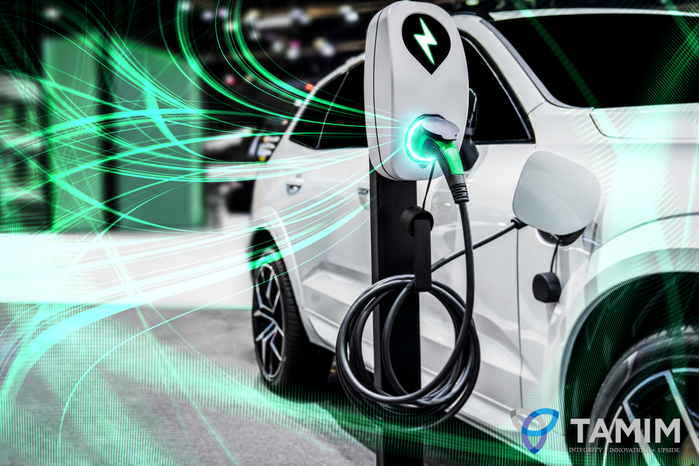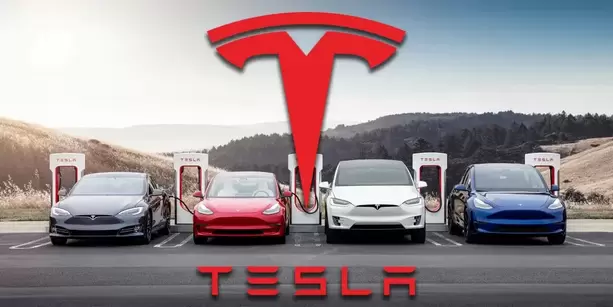
With stock prices down and sales continuing to rise, let’s take a look at some key players that investors could consider in 2023.
Tesla: still fascinating the world

Even after a fast share price recovery to start 2023, Tesla stock is still down almost 33% over the past 12 months. The company is out to prove it remains the EV industry leader and is making moves to swallow up more market share.
Tesla’s latest earnings report capped off a tremendous year, posting record profits and cash flow, despite numerous challenges from global supply chain kinks, to shutdowns at its Shanghai production facility due to rampant COVID-19 cases in China, to CEO Elon Musk’s high profile takeover of Twitter.
In the Q4 2022, Tesla recorded year-over-year revenue growth of 37% to US$24.3 billion, translating to net income of US$3.7 billion. Whilst free cash flow for the quarter declined against the corresponding period in 2021, this was mainly due to a step-up in inventory between the third and fourth quarter of 2022. The US$7.6 billion of free cash flow for full-year 2022 represented a 51% jump from 2021, in which Tesla generated just over US$5 billion in free cash flow.
It’s clear that Tesla’s operating performance is strengthening. Maybe not as much as some analysts and investors hoped, but that’s why the shares have become less egregiously priced. Some feared Tesla’s recent vehicle price cuts across its sales regions indicated a drop in demand that signals a slowing business. But investors should look at results, and not just what prior expectations from analysts have been.
According to Musk during the company’s earnings call, demand continues to outstrip the supply, and Tesla is focused on ramping up volume while decreasing manufacturing costs.
Musk said:
“Thus far in January, we’ve seen the strongest orders year-to-date than ever in our history. We currently are seeing orders at almost twice the rate of production.”
Nio: China’s answer to Tesla

Chinese electric car maker Nio (NYSE: NIO) was one of the hardest-hit EV stocks in 2022. The company has been publicly traded since 2018 and is not shy about battling Tesla for market share in the biggest global markets.
Similar to Tesla, the company is more than a simple car manufacturer. The company designs and manufactures premium EVs with a focus on battery technology, connectivity, and autonomous driving. It also offers EV charging solutions and other services, including insurance, maintenance, roadside assistance, and an enhanced data package.
Nio has built its customer base partially by offering its Chinese customers more than just smart EVs. Its SUV and sedan models are sold with an option to use a subscription for swapping drained batteries for fresh ones in just minutes (Batteries as a Service, or BaaS). The strategy lowers the initial cost to customers and differentiates Nio from its competitors. It also has aimed to build a loyal following with Nio Houses and other gathering spaces many Chinese consumers have embraced.
The company is now building out that model across Europe. To date, Nio has more than 35 service centers in the EU along with several Nio Houses, battery swap stations, and other charging infrastructure.
In lieu of these exciting concepts, Nio continues to be a loss making company. Nio recently reported a quarterly record of 40,052 units delivered, generating revenue worth US$2.3 billion but this growth is yet to translate to a profitable bottom line.
Gross margin compression and a muted outlook for the next 6 months attracted several analyst downgrades. However, investors wouldn’t want to write off the stock just yet.
Nio is transitioning its EV models to a second-generation technology platform, NT2.0. This means that the company was busy selling down older inventory in the last quarter and reportedly also offered incentives to customers, which added to its costs. Additionally, Nio is still preparing its manufacturing lines to produce the new models, which is a major reason why it sees lower production and fewer deliveries in the first quarter.
Nvidia: on the way up
making best-in-class semiconductors for PC and console gaming. But calling Nvidia just a graphics chip maker would be like calling Tesla just a car company. Sure, it’s an accurate description, but it doesn’t really do the business justice.The software Nvidia engineers developed to render light and physics for game graphics became the foundation for a new computing model based on artificial intelligence. Nvidia made the AI platform open source to entice academics and developers to buy-in. The strategy was a huge success, moving Nvidia hardware beyond gaming into super computers and data centers.
While data chip centres and gaming contribute the majority of company revenue, Nvidia’s researchers have built algorithmic models capable of solving complex problems, like autonomous vehicles. CEO Jensen Huang unveiled an autonomous vehicle (AV) computer in 2017 that was no bigger than a lunchbox but still capable of processing 320 trillion instructions per second, enough horsepower to process data from real time sensor streams, and then push everything up to the cloud for further analysis.
Fast forward to today and the technology has resulted in hundreds of development partnerships. Today Nvidia has engineers working on AV technology with Volkswagen, Audi, Toyota, Hyundai, Volvo and Mercedes-Benz.
Even in the wake of a strong rebound in recent months, shares in Nvidia remain well below their all-time high. Nvidia’s chips have a plethora of potential uses in things like metaverse technology, AI, and autonomous vehicles. Revenue from the professional visualisation and automotive segments grew by 65% and 86%, respectively, year over year in the latest quarter
Nvidia is a hardware company that made the transition to AI software. It is an opportunity to invest in the “picks and shovels” of the new automotive economy as its software/hardware solutions become the brains of many of the world’s best brands.

